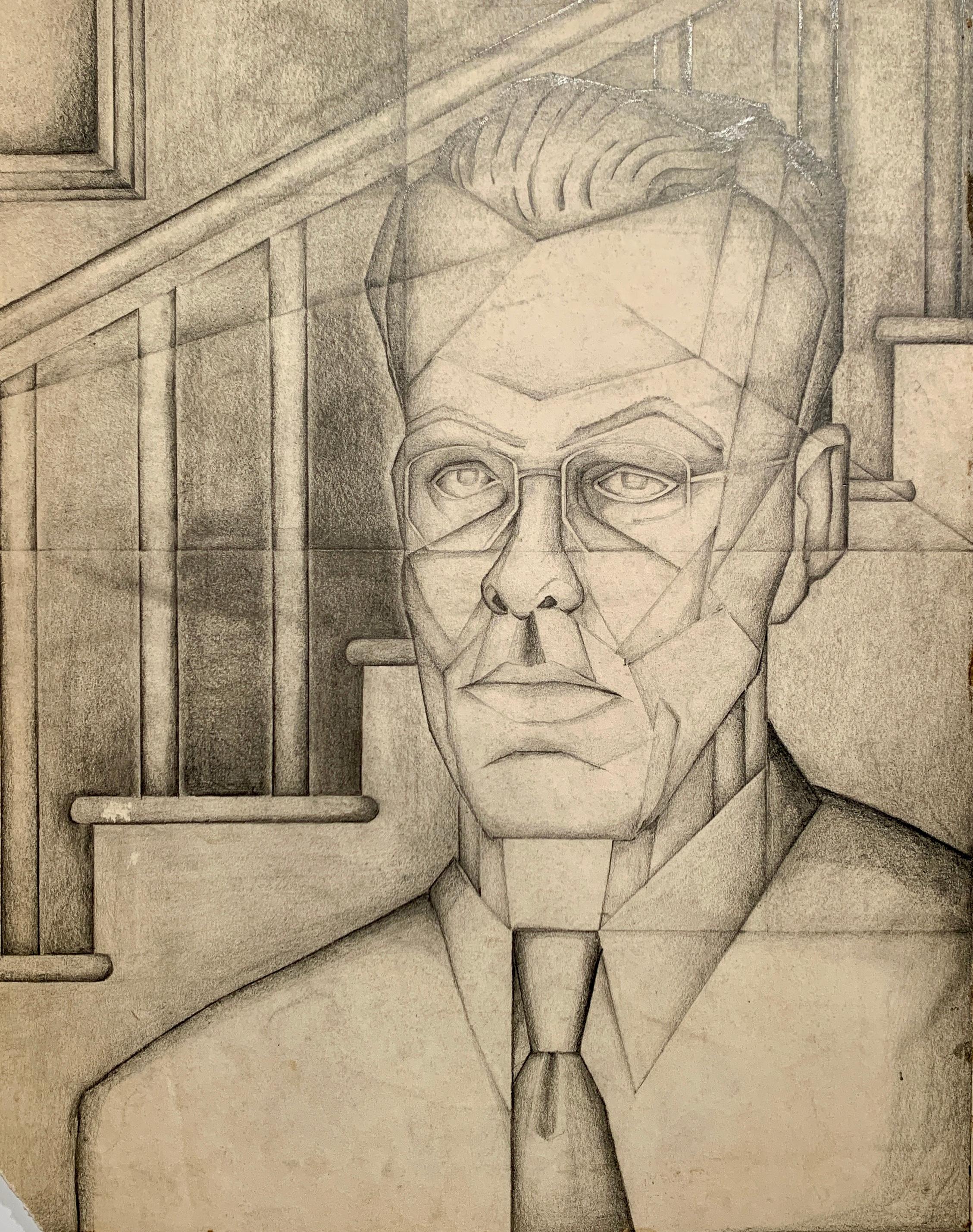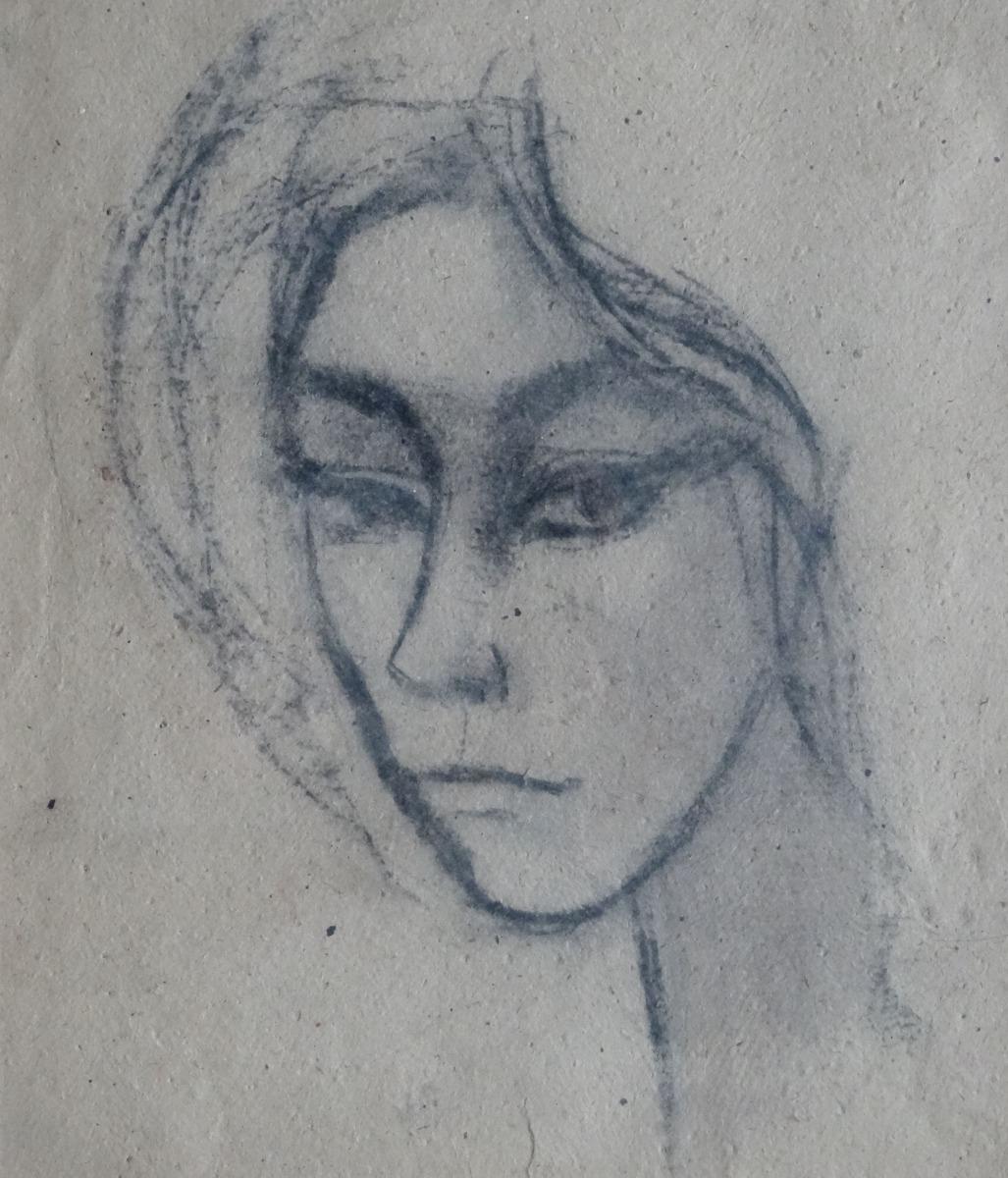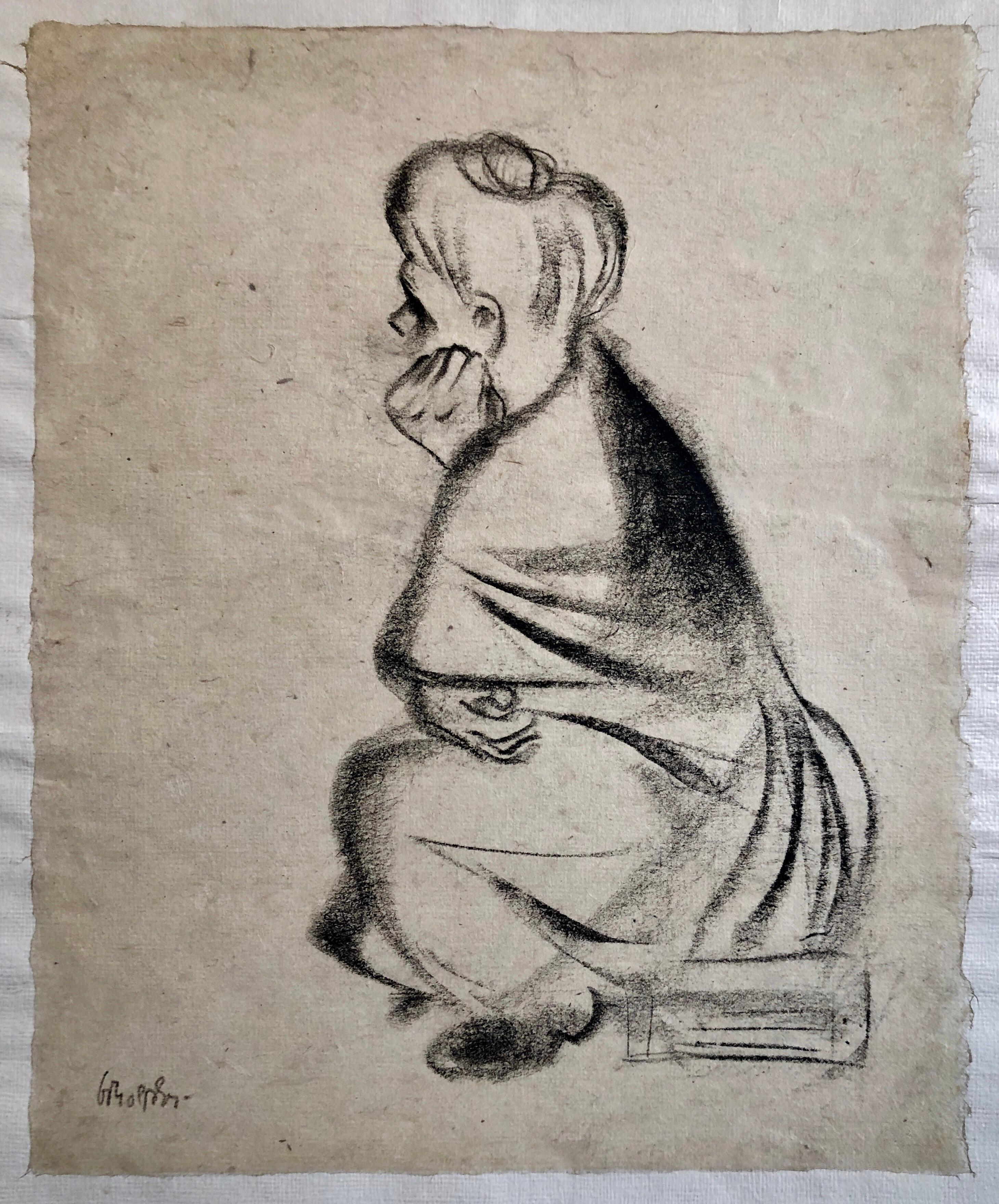Items Similar to Stevedore Barcelona Spain charcoal drawing
Want more images or videos?
Request additional images or videos from the seller
1 of 12
Dionis BaixerasStevedore Barcelona Spain charcoal drawingc.1900
c.1900
About the Item
Dionis Baixeras i Verdaguer (1862-1943) - Docker - Charcoal drawing
Drawing measurements 58x43 cm.
Frame measurements 74x59 cm.
Dionisio Baixeras Verdaguer (Barcelona, 1862-1943), Dionís Baixeras i Verdaguer in Catalan, was a Spanish naturalist painter and draftsman.
At the age of fifteen he entered the La Lonja School in his hometown. He defended an art of Christian inspiration. He was one of the founders of the San Lucas Artistic Circle. His painting is of a historicist type, influenced by the Olot School. His works are exhibited in various museums such as:
Musée d'art et d'industrie de Roubaix, France
Museum of Fine Arts of Asturias
Portrait of a boatman in Barceloneta, (1890), Víctor Balaguer Library and Museum
"Boatmen of Barcelona", (1886), The Metropolitan Museum of Art, New York
- Creator:Dionis Baixeras (1962 - 1943, Spanish)
- Creation Year:c.1900
- Dimensions:Height: 22.84 in (58 cm)Width: 16.93 in (43 cm)
- Medium:
- Movement & Style:
- Period:
- Condition:
- Gallery Location:Barcelona, ES
- Reference Number:1stDibs: LU1155214274322
About the Seller
5.0
Platinum Seller
These expertly vetted sellers are 1stDibs' most experienced sellers and are rated highest by our customers.
Established in 2007
1stDibs seller since 2019
298 sales on 1stDibs
Typical response time: <1 hour
- ShippingRetrieving quote...Ships From: sitges, Spain
- Return PolicyA return for this item may be initiated within 10 days of delivery.
More From This SellerView All
- Spanish folk dance Jota pastel drawingBy Alfredo OpissoLocated in Barcelona, BarcelonaAlfredo Opisso Cardona (1907-1980) - Jota - Pastel Measures work 46x36cm. Frame measures 65x55 cm.Category
1960s Modern Figurative Drawings and Watercolors
MaterialsPastel
- beggars spanish modernism colored pencilsBy Ricard Opisso SalaLocated in Barcelona, BarcelonaRicard Opisso - Beggars - Colored pencils Measurements drawing 21x31cm. Frame measures 39x48 cm. Damaged paper at bottom. Anti-reflective glass. Son of Alfredo Opisso y Viñas, journalist, historian and critic, and of Antonia Sala y Gil, his sister Regina Opisso, was also a writer. He comes from an enlightened family full of artists. His paternal grandfather was Josep Opisso y Roig, journalist and director of the Diari de Tarragona, father of the also writers Antonia Opisso y Viña and Antoni Opisso y Viña. His maternal great-grandfather was the painter Pere Pau Montaña, his maternal grandfather the fabulist Felipe Jacinto Sala and his maternal uncle, the painter Emilio Sala y Francés. His nephew was Arturo Llorens y Opisso, a writer better known under his pseudonym Arturo Llopis. Although he was born in Tarragona, his family moved to Barcelona when Opisso was only two years old. In modernist Barcelona at the end of the 19th century, Opisso worked as an assistant to Antonio Gaudí in the works of the Sagrada Familia in Barcelona since 1892. He was linked to the group Els Quatre Gats, along with Ramón Casas...Category
1940s Modern Portrait Drawings and Watercolors
MaterialsColor Pencil
- postwar characters Spanish Civil War crayons drawingBy Alfredo OpissoLocated in Barcelona, BarcelonaAlfredo Opisso Cardona (1907-1980) - Post-war characters - Colored crayons Crayons. Frame in poor condition. Measures work 32x20cm. Frame measures 55x43 cm.Category
1940s Modern Figurative Drawings and Watercolors
MaterialsCrayon
- Sit woman pastel drawingBy Rafael Duran BenetLocated in Barcelona, BarcelonaRafael Duran Benet (1931-2015) - Sit woman - Pastel Drawing measurements 62x42 cm. Frame measurements 82x62 cm. Rafael Duran Benet (Terrassa, 1931 - Barcelona, 2015) is a Catalan painter...Category
1970s Post-Impressionist Portrait Drawings and Watercolors
MaterialsPastel
- Woman smoking pencil drawingLocated in Barcelona, BarcelonaFrame size 74x61 cm.Category
1950s Academic Portrait Drawings and Watercolors
MaterialsPencil
- Ballpoint pen drawing female faceBy José Luis FuentetajaLocated in Barcelona, BarcelonaFrame size 44x35 cm. Is born in Madrid on the 21st july 1951. After attending primary school, he starts to grow an enormous tendency for drawing. At the age of 14 he begins to work in advertising and attends to the Vallecas school of arts. At the age of 14 he travels to Switzerland and in Geneve he gets intensly into painting and decides to dedicate himself only to it. When he returns to Spain he enrolls Arts Studies, and at the begining of summer '66, he visits Sitges, where he'll come back year after year and where ultimately he'll set his home. At this time he starts selling his painting in the flea market in Madrid and later in Sitges, setting himself on the street, thus completing his studies and making it economically. While he's in Madrid he recives lessons by Pedro Mozas at Bellas Artes and starts to learn profoundly about painting. In 1969 he starts painting portraits in the streets. In Sitges he creates, with other friends, a great artistic atmosphere in the Paseo de la Ribera, by the sea, that today still exists. He starts travelling through Europe, visiting and painting in Paris, London and Amsterdam. In the middle of this bohemian epoque, he moves to the Cannary Islands during the winters for 5 years in a row, he moves in the Parque de Santa Catalina "Las Palmas de Gran Canaria" where he works and meet all sorts of people in the streets, which later would mark his pictoric line. He becomes friend with Sidney Nagley in 1969, who organizes his first exhibition in Toronto, Canada. Afterwards he'll leave his studies and start painting exclusively in his studio. He gathers his first exhibition in the Ateneu of Barcelona in 1970. He befriends with the art critic of La Vanguardia, Fernando Gutierrez and the Count of Caralt orders him a set of illustration for a new edition of Garcia Lorcas Romancero Gitano. His first exhibition in a commercial gallery is done in the Majestic Gallery in Barcelona with a gorgeous collection of nudity drawings. He achieves huge success and for some years he affords his painting thanks to those drawings. During a period in Madrid, Mr Ponce de León...Category
2010s Realist Portrait Drawings and Watercolors
MaterialsBallpoint Pen
You May Also Like
- UntitledBy Mark TobeyLocated in New York, NYTobey's work resembles Abstract Expressionism and Asian calligraphy.Category
1920s American Modern Portrait Drawings and Watercolors
MaterialsCharcoal
- 1940s Charcoal and Pencil Portrait of a ManLocated in Arp, TXArtist Unknown "Tie and Glasses" c. 1940s Charcoal and pencil on paper 13.5"x17" image 15.5"x19" paper unframed $250 Unsigned *Listed price reflects custom framing selected by seller...Category
1940s Modern Portrait Drawings and Watercolors
MaterialsPaper, Charcoal, Carbon Pencil
- Portrait 1957, paper, charcoal, 36x31 cmLocated in Riga, LVPortrait 1957, paper, charcoal, 36x31 cm The focus of the portrait is a woman. Charcoal, with its rich and versatile qualities, has been utilized by the artist to capture the vario...Category
1950s Modern Portrait Drawings and Watercolors
MaterialsPaper, Charcoal
- Self Portrait (original signed drawing)By John HelikerLocated in New York, NYJohn Heliker Self Portrait, 1991 Charcoal Pencil on Paper (with original Kraushaar Galleries label verso) Signed on the front bears the original KRAUSHAAR GALLERIES label on the verso on the frame Vintage metal frame included Self portrait done in charcoal pencil by distinguished American artist John Heliker. Hand signed on the front This work is framed - bears the label of the renowned KRAUSHAAR GALLERIES on the verso. Image size: 13 inches by 10 inches; Framed: 18 1/2 inches by 14 1/2 inches About John Heliker from The New York Times Obituary, 2000 (Roberta Smith) John Heliker, a painter and teacher who was a fixture of the New York art world for nearly seven decades, died on Tuesday at the Sonojee Estate, a health center in Bar Harbor, Me. He was 91 and had lived in New York during most of his career, spending summers on Cranberry Island...Category
Late 20th Century Modern Portrait Drawings and Watercolors
MaterialsCharcoal, Carbon Pencil, Paper
- Rare Modernist Hungarian Rabbi Pastel Drawing Gouache Painting Judaica Art DecoBy Hugó ScheiberLocated in Surfside, FLRabbi in the synagogue at prayer wearing tallit and tefillin. Hugó Scheiber (born 29 September 1873 in Budapest – died there 7 March 1950) was a Hungarian modernist painter. Hugo Scheiber was brought from Budapest to Vienna at the age of eight where his father worked as a sign painter for the Prater Theater. At fifteen, he returned with his family to Budapest and began working during the day to help support them and attending painting classes at the School of Design in the evening, where Henrik Papp was one of his teachers. He completed his studies in 1900. His work was at first in a post-Impressionistic style but from 1910 onward showed his increasing interest in German Expressionism and Futurism. This made it of little interest to the conservative Hungarian art establishment. However, in 1915 he met the great Italian avant-gardist Filippo Tommaso Marinetti and the two painters became close friends. Marinetti invited him to join the Futurist Movement. The uniquely modernist style that he developed was, however, closer to German Expressionism than to Futurism and eventually drifted toward an international art deco manner similar to Erté's. In 1919, he and his friend Béla Kádar held an exhibition at the Hevesy Salon in Vienna. It was a great success and at last caused the Budapest Art Museum to acquire some of Scheiber's drawings. Encouraged, Scheiber came back to live in Vienna in 1920. A turning point in Scheiber's career came a year later, when Herwarth Walden, founder of Germany's leading avant-garde periodical, Der Sturm, and of the Sturm Gallery in Berlin, became interested in Scheiber's work. Scheiber moved to Berlin in 1922, and his paintings soon appeared regularly in Walden's magazine and elsewhere. Exhibitions of his work followed in London, Rome, La Paz, and New York. Scheiber's move to Germany coincided with a significant exodus of Hungarian artists to Berlin, including Laszlo Moholy-Nagy and Sandor Bortnyik. There had been a major split in ideology among the Hungarian avant-garde. The Constructivist and leader of the Hungarian avantgarde, Lajos Kassák (painted by Hugó Scheiber in 1930) believed that art should relate to all the needs of contemporary humankind. Thus he refused to compromise the purity of his style to reflect the demands of either the ruling class or socialists and communists. The other camp believed that an artist should be a figurehead for social and political change. The fall out and factions that resulted from this politicisation resulted in most of the Hungarian avant gardists leaving Vienna for Berlin. Hungarian émigrés made up one of the largest minority groups in the German capital and the influx of their painters had a significant effect on Hungarian and international art. Another turning point of Scheiber's career came in 1926, with the New York exhibition of the Société Anonyme, organized by Katherine Dreier. Scheiber and other important avant garde artists from more than twenty-three countries were represented. In 1933, Scheiber was invited by Marinetti to participate in the great meeting of the Futurists held in Rome in late April 1933, Mostra Nazionale d’Arte Futurista where he was received with great enthusiasm. Gradually, the Hungarian artists began to return home, particularly with the rise of Nazism in Germany. Kádar went back from Berlin in about 1932 and Scheiber followed in 1934. He was then at the peak of his powers and had a special flair in depicting café and cabaret life in vivid colors, sturdily abstracted forms and spontaneous brush strokes. Scheiber depicted cosmopolitan modern life using stylized shapes and expressive colors. His preferred subjects were cabaret and street scenes, jazz musicians, flappers, and a series of self-portraits (usually with a cigar). his principal media being gouache and oil. He was a member of the prestigious New Society of Artists (KUT—Képzőművészek Új Társasága)and seems to have weathered Hungary's post–World War II transition to state-communism without difficulty. He continued to be well regarded, eventually even receiving the posthumous honor of having one of his images used for a Russian Soviet postage stamp (see image above). Hugó Scheiber died in Budapest in 1950. Paintings by Hugó Scheiber form part of permanent museum collections in Budapest (Hungarian National Museum), Pecs (Jannus Pannonius Museum), Vienna, New York, Bern and elsewhere. His work has also been shown in many important exhibitions, including: "The Nell Walden Collection," Kunsthaus Zürich (1945) "Collection of the Société Anonyme," Yale University Art Gallery, New Haven, Connecticut (1950) "Hugó Scheiber: A Commemorative Exhibition," Hungarian National Museum, Budapest (1964) "Ungarische Avantgarde," Galleria del Levante, Munich (1971) "Paris-Berlin 1900-1930," Centre Georges Pompidou, Paris (1978) "L’Art en Hongrie, 1905-1920," Musée d’Art et l’Industrie, Saint-Etienne (1980) "Ungarische Avantgarde in der Weimarer Republik," Marburg (1986) "Modernizmus," Eresz & Maklary Gallery, Budapest (2006) "Hugó Scheiber & Béla Kádár," Galerie le Minotaure, Paris and Tel Aviv (2007) Hugó Scheiber's paintings continue to be regularly sold at Sotheby's, Christie's, Gillen's Arts (London), Papillon Gallery (Los Angeles) and other auction houses. He was included in the exhibition The Art Of Modern Hungary 1931 and other exhibitions along with Vilmos Novak Aba, Count Julius Batthyany, Pal Bor, Bela Buky, Denes Csanky, Istvan Csok, Bela Czobel, Peter Di Gabor, Bela Ivanyi Grunwald, Baron Ferenc Hatvany, Lipot Herman, Odon Marffy, C. Pal Molnar...Category
Early 20th Century Modern Figurative Paintings
MaterialsPaper, Charcoal, Pastel, Watercolor, Gouache
- Charcoal Drawing "Waiting" Pensive Woman Americana WPA ArtistBy William GropperLocated in Surfside, FL14x11.5 image size , 22.5x17.5 backing size The New-York born artist William Gropper was a painter and cartoonist who, with caricature style, focused on social concerns, and was ac...Category
Mid-20th Century Modern Portrait Drawings and Watercolors
MaterialsCharcoal





